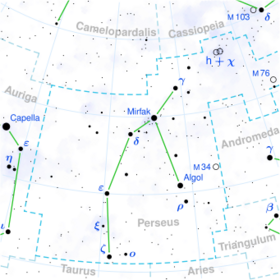Astronomy:12 Persei
| Observation data Equinox J2000.0]] (ICRS) | |
|---|---|
| Constellation | Perseus |
| Right ascension | 02h 42m 14.91569s[1] |
| Declination | +40° 11′ 38.1898″[1] |
| Apparent magnitude (V) | 4.94[2] |
| Characteristics | |
| Spectral type | F9 V[3] |
| U−B color index | +0.08[2] |
| B−V color index | +0.56[2] |
| Astrometry | |
| Radial velocity (Rv) | 5.20[4] km/s |
| Proper motion (μ) | RA: −17.20[1] mas/yr Dec.: −183.30[1] mas/yr |
| Parallax (π) | 41.34 ± 0.43[1] mas |
| Distance | 78.9 ± 0.8 ly (24.2 ± 0.3 pc) |
| Orbit | |
| Period (P) | 330.98[5] d |
| Semi-major axis (a) | 53.18[6] mas |
| Eccentricity (e) | 0.663[5] |
| Inclination (i) | 127.17[6]° |
| Details | |
| 12 Per A | |
| Mass | 1.382±0.019[5] M☉ |
| Radius | 1.55[5] R☉ |
| Luminosity | 3.02[5] L☉ |
| Surface gravity (log g) | 4.20±0.10[5] cgs |
| Temperature | 6195±200[5] K |
| Metallicity [Fe/H] | ≥0.35[5] dex |
| Rotational velocity (v sin i) | 13[7] km/s |
| Age | 1.12[5] Gyr |
| 12 Per B | |
| Mass | 1.240±0.017[5] M☉ |
| Radius | 1.31[5] R☉ |
| Luminosity | 1.86[5] L☉ |
| Surface gravity (log g) | 4.30±0.10[5] cgs |
| Temperature | 6000±200[5] K |
| Other designations | |
| Database references | |
| SIMBAD | data |
12 Persei (12 Per) is a double-lined spectroscopic binary star system in the northern constellation Perseus. Its combined apparent magnitude is 4.94,[2] which means it can be viewed with the naked eye. Based upon parallax measurements, this system is about 79 light years away from the Sun.[1]
The magnitude difference between the two components is estimated to be 0.51. Based upon this, the primary has a mass around 138% of the Sun, 155% of the Sun's radius, and shines with three times the Sun's luminosity. The smaller secondary component is also larger than the Sun, with 124% of the Sun's mass, 131% of the radius of the Sun, and has 186% of the Sun's luminosity.[5] The stellar classification of the primary is F9 V,[3] which suggests it is an F-type main sequence star. The pair have an estimated age of just over a billion years.[5]
The pair orbit each other with a period of 331 days and an eccentricity of 0.663.[5] The semimajor axis of their orbit is 1.27 AU, which means the inner stability radius for a hypothetical planet orbiting the pair would be at 4.35 AU. This lies outside the habitability zone for this system.[9]
References
- ↑ 1.0 1.1 1.2 1.3 1.4 1.5 van Leeuwen, F. (2007), "Validation of the new Hipparcos reduction", Astronomy and Astrophysics 474 (2): 653–664, doi:10.1051/0004-6361:20078357, Bibcode: 2007A&A...474..653V.
- ↑ 2.0 2.1 2.2 2.3 Mermilliod, J.-C. (1986), "Compilation of Eggen's UBV data, transformed to UBV (unpublished)", SIMBAD Astronomical Database, Bibcode: 1986EgUBV........0M.
- ↑ 3.0 3.1 Abt, Helmut A. (2009), "MK Classifications of Spectroscopic Binaries", The Astrophysical Journal Supplement 180 (1): 117–118, doi:10.1088/0067-0049/180/1/117, Bibcode: 2009ApJS..180..117A.
- ↑ Pourbaix, D. et al. (September 2004), "SB9: The ninth catalogue of spectroscopic binary orbits", Astronomy and Astrophysics 424: 727–732, doi:10.1051/0004-6361:20041213, Bibcode: 2004A&A...424..727P.
- ↑ 5.00 5.01 5.02 5.03 5.04 5.05 5.06 5.07 5.08 5.09 5.10 5.11 5.12 5.13 5.14 5.15 5.16 Leushin, V. V.; Kuznetsov, M. K. (2008), "Chemical Composition and Evolutionary Status of Spectral Binary Star 12 Per", Odessa Astronomical Publications 21: 57, Bibcode: 2008OAP....21...57L.
- ↑ 6.0 6.1 Bagnuolo, William G. Jr. et al. (June 2006), "The star 12 Persei and separated fringe packet binaries (SFPB)", in Monnier, John D.; Schöller, Markus; Danchi, William C., Advances in Stellar Interferometry, Proceedings of the SPIE, 6268, pp. 62682T, doi:10.1117/12.672275, 62682T, Bibcode: 2006SPIE.6268E..2TB.
- ↑ Bernacca, P. L.; Perinotto, M. (1970), "A catalogue of stellar rotational velocities", Contributi Osservatorio Astronomico di Padova in Asiago 239 (1): 1, Bibcode: 1970CoAsi.239....1B.
- ↑ "* 12 Per". SIMBAD. Centre de données astronomiques de Strasbourg. http://simbad.u-strasbg.fr/simbad/sim-basic?Ident=%2A+12+Per.
- ↑ Jaime, Luisa G. et al. (September 2014), "Habitable zones with stable orbits for planets around binary systems", Monthly Notices of the Royal Astronomical Society 443 (1): 260–274, doi:10.1093/mnras/stu1052, Bibcode: 2014MNRAS.443..260J.
 |

